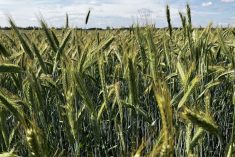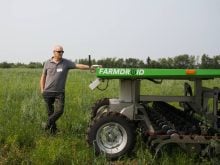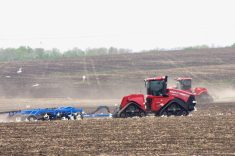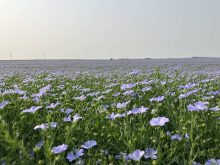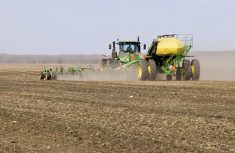Manitoba’s crop experts have some blanket advice for producers fighting an increasingly late spring: seed heavy, seed shallow, and go as soon as you can.
“Delayed” has been an understatement when it comes to field conditions in Manitoba — the legacy of three Colorado lows in three weeks and continued rain and cold.
Only four per cent of the province’s acres were planted as of the second week of May, according to the last provincial crop report — at a time of year when producers could typically expect to be half done seeding, according to the five-year average.
Read Also

Still hard to predict precise fertilizer payback
Despite decades of advances, international research finds no clear answer for where and when adding nutrient will fail to boost growth.
There had been better progress in central and southwest Manitoba, the province reported, although the Red River Valley remained largely under water and the Interlake and northwest remained similarly behind.
“Farmers are extremely concerned about seeding delays, leading some farmers to switch planned corn or soybean acres into canola and spring wheat, while planned field pea acres may see a decline as well,” the crop report said.
Pulses
While producers may well be feeling the crunch, provincial pulse specialist Dennis Lange urged producers to avoid the temptation of going before the field is ready.
“You don’t want to muck things in the ground,” he said, speaking as part of a weekly Crop Talk webinar put on by the province.
This spring may also lend itself to some less than usual seeding priorities.
Soybeans are not typically the early-seeded crop of choice when compared to field peas. This year, however, Lange noted, if farmers have to plant soybeans before peas go in the ground, that’s what they should be doing.
“With the season that we have this year, I think you’d take advantage of what you can,” he said.
Lange said he’s been referring back to crop insurance data and, while there’s a clear benefit to planting peas in late April or early May, it’s still not too late despite the calendar moving into the latter part of May.
Yield data collected in years where seeding was also later or delayed shows that pea crops planted in the third and fourth week of May still hold their own, Lange said.
That grace period, however, will only last so long before the potential yield drop-off begins to weigh.
If peas are still not planted in the last few days of May or early June, Lange said it’s time to consider alternatives, despite still being well within the crop insurance seeding deadline. The Manitoba Agricultural Services Corporation (MASC) sets a full coverage deadline of June 15 for field peas, and includes an extended, reduced coverage window until June 20.
Producers who typically opt for a longer-maturing soybean variety may, for obvious reasons, not be able to count on their standby, Lange noted, although he added that growers are generally picking varieties based on their maturity zones in the first place.
Producers will also want to be a little heavy handed when it comes to seed.
“You want to keep your plant populations up this year, so don’t skimp on the seed, especially when it’s in that cold, wet soil,” Lange said. “Don’t plant any deeper than necessary for both peas and soybeans. Half an inch, with the moisture that we have this year, is good.”
Cereals and corn
Anne Kirk, provincial cereal specialist, noted the risk of fall frost damage, as well as more danger of damaging heat during key periods of crop development, that will come with this year’s delayed seeding.
Yield-determining factors like tillering, heads per area, kernel number per head and kernel weight will feel those stresses, she noted.
“It’s important to make sure we are optimizing our seeding by planting really well,” she said, adding that, if moisture permits, that includes targeting the shallower end of seeding depth recommendations to promote faster germination.
It’s also important to consider optimum germination temperatures and how that should affect the crop sequence,” she said.
Like Lange, Kirk also honed in on higher plant populations.
Growers considering switching varieties or crop types might find themselves in a tough spot, Kirk said, specifically when it comes to spring wheat, oats and barley.
“I have been contacting seed growers throughout the province and there are supplies of some crops, but variety choice is fairly limited,” she said. “So there are supplies of seeds if (growers) are changing crop types, but there wouldn’t be a huge selection for people looking at changing to a shorter-season variety.”
There are, however, some shorter-season corn hybrids available.
Producers will likely be fine with their normal corn choice, assuming they can either get on their field by the last full week of May, or if the corn is meant for silage, she said May 18, “but for grain corn, if we’re not able to seed it early next week, then farmers should consider switching to a shorter-season variety.”
Canola
It is not yet time to panic, Lionel Kaskiw, provincial ag adaptation specialist, said of canola and other oilseeds.
Unlike some other crops, canola yield potential is relatively slow to drop off, while MASC seeding deadlines for full coverage don’t kick in until June 10 or June 15, depending on risk area.
At the same time, Kaskiw said, “We do have the ability to get the crop in fast.”
Producers who opt for less traditional canola seeding methods, however, such as broadcasting or aerial planting should be aware of insurance restrictions, he noted.
MASC will require those fields to have seed incorporated mechanically ahead of the seeding deadline, and the crop must be fully established in order to make an insurance claim.
Kaskiw noted that the biggest concern, whether for a pulse crop or an oilseed, is the possibility of flowering during the heat of the summer, something well linked to flower abortion and yield hit.
“Planting now usually means flowering in mid-July and that’s usually when we get our heat,” he said, noting the risk of aborted flowers.
Producers will also want to develop a seeding plan right away, regardless of crop, he said.
“Plant where you can plant, and if it means bouncing around from crop to crop, you just need to do that. And if it means that you’re going to look at making some changes, then start making those decisions now, so you’re prepared,” he said.




